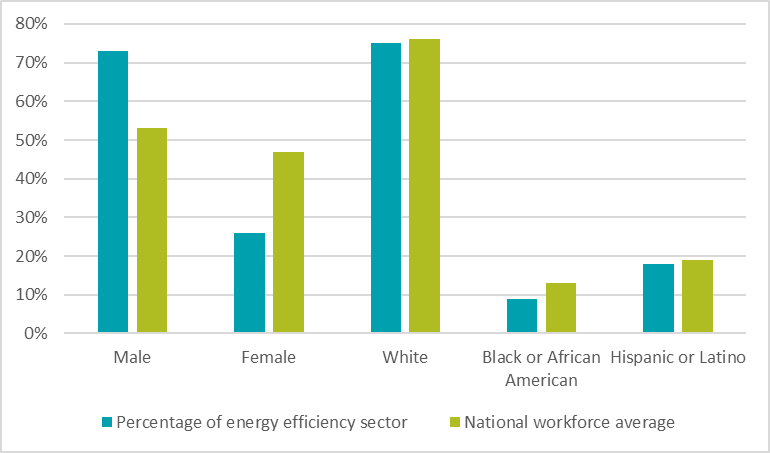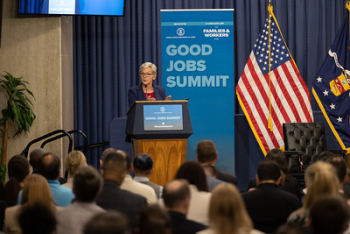

By Yiran He | Thu, September 26, 24
Energy efficiency represents the largest source of employment in the clean energy sector, with most job growth happening in heating, ventilation, and cooling jobs. And the demand for clean energy workers is growing. The expected increased demand for clean energy and energy efficiency upgrades and installations presents an opportunity for heightened attention to diversity, equity, inclusion, and accessibility in the workforce. This upward trend also creates an opportunity for states to create good quality local jobs, targeted towards disadvantaged communities. In this blog, we provide recommendations on how states can leverage federal resources to create lasting, impactful workforce programs, centered on equity.
What is an Equitable Energy Efficiency Workforce?
An equitable energy efficiency workforce seeks to uplift underserved communities and represent the communities it serves. The energy efficiency job market is growing and provides competitive pay, but not everyone is reaping its benefits equally. A look at the current make-up of the industry shows that the energy efficiency workforce is disproportionately white men as of 2023, as compared to national energy workforce demographics; less than 30 percent are female, and Black and Hispanic workers make up nine percent and 18 percent respectively.
For an energy and economic transition to be just, program designers must proactively center the needs of the populations that have been historically underserved, underrepresented, and marginalized.
In 2023, the percentage of energy efficiency workers represented by a union or covered under a project labor or collective bargaining agreement (13 percent) was higher than the national energy workforce average (11 percent). Overall, unionization rates in clean energy surpassed those in traditional energy employment. Thus, unions also play an important role in the workforce ecosystem and this just transition. Through collective bargaining, they can secure better pay and benefits for member workers. Additionally, their work can improve social safety nets such as minimum wage levels, worker protections, and other benefits that help all workers but are especially important for low-income individuals and communities. They also provide other benefits such as pre-apprenticeship programs for workers to move into formal apprenticeships.
As states address current inequities in the workforce landscape and advance the just transition, state energy offices and other stakeholders can also examine the energy equity of efficiency programs by using the four pillars of energy equity summarized by The American Council for an Energy-Efficient Economy (ACEEE) Energy Equity Initiative based on the Urban Sustainability Director’s Network (USDN) four dimensions of equity. The remainder of this blog illustrates how they can be embedded into workforce development.
Structural Equity | Procedural Equity | Distributional Equity | Transgenerational Equity |
| Decision makers recognize the historical, cultural, and institutional dynamics that have led to clean energy inequities. | Decision makers create inclusive and accessible processes for developing and implementing clean energy programs. | Clean energy policies and programs fairly distribute benefits and burdens across all segments of communities. | Decision makers consider the impact on future generations of the clean energy policies and programs they develop. |
Fig 2. Four pillars of energy equity. Source: from The American Council for an Energy-Efficient Economy (ACEEE) Energy Equity Initiative based on the Urban Sustainability Director’s Network (USDN).
Distributional Equity
States can embed distributional equity by partnering with community organizations, labor groups, and local businesses, which are usually better connected with residents than state agencies. Partnering with local businesses for paid on-the-job training can ensure growth of the industry within the community. States can replicate or adapt the examples below to alleviate distributional inequities in the energy efficiency workforce.
- In New Jersey, PSE&G’s Clean Energy Future - Energy Efficiency Program partners with community organizations and the New Jersey Department of Labor to recruit and retain participants.
- The District of Columbia Sustainable Energy Utility Energy Efficiency Workforce Development Program leverages community-based organizations to recruit workers for the program. Training is offered free of charge, and participants are paid a living wage. The program also provides general education on clean energy and training in people skills such as interviewing, public speaking, resume drafting, and budgeting.
- New York's Clean Heat Connect Program supports trainees and businesses throughout the state. The program allows for heat pump contractors to sponsor trainees and offers training and wage subsidies, as well as additional support for advertising and equipment.
- Maine’s Apprenticeship Program allows companies to sponsor an apprentice and provide training through the program with the state covering up to 50 percent of the cost of classroom instruction.
States can also invest in programs to alleviate distributional inequities in business ownership. Community wealth and income gaps, along with limited access to capital, disproportionately impact people of color and women. According to US Census data, people of color make up almost 40 percent of the US population, but only own 18.3 percent of employer businesses. States can ensure that funding programs for early-stage companies have equity targets for ownership demographics, and that workforce programs include business management training. States can focus on equity through program design in many ways, for example:
- In New York, NYSERDA’s Entrepreneurs-in-Residence (EIR) Program guides early-stage companies through management projects and issues. Climate technology startups are matched with executive-level mentors.
- The Maryland Energy Innovation Accelerator (MEIA, part of Maryland’s Clean Energy Center) matches inventors and entrepreneurs with strategic partners and executives to create clean energy businesses. The Energy-Executive-in-Residence Program, under MEIA, helps build businesses before a company is formally created.
- The Emerald Cities Collaborative’s E-Contractor Academy is a seven-week training program where small, women- and minority-owned business contractors learn to perform energy efficiency and renewable energy retrofit projects. Contractors learn about the regulatory and technical landscapes of green infrastructure projects, and about bidding for and managing large-scale projects.
Structural Equity
Structural equity recognizes historical, cultural, and institutional dynamics and reforms programs that perpetuate disparities. To address this inequity, policymakers and program implementers can seek to reform programs that perpetuate disparities and/or implement programs that are designed to overcome disparities. For workforce development, addressing existing inequities can mean designing a program that goes beyond training, alleviating barriers with wrap-around services, payment for attending training, community support systems, and clear job pathways.
Wrap-around services can address barriers such as lack of childcare, lack of driver’s license or other transportation forms, and lack of stable housing. These services also include enabling pathways for formerly incarcerated individuals with a record of non-violent criminal offenses to join the workforce as part of their rehabilitation.
- Massachusetts’ Clean Energy Pathways Program aims to grow and diversify the energy efficiency workforce and also focuses on distributive justice as it is open to and tailored to serve solely individuals from disadvantaged communities. Job seekers are offered paid training and hands-on experience, as well as job placement assistance and mentorships.
- The District of Columbia Sustainable Energy Utility Energy Efficiency Workforce Development Program offers specific wrap-around services that alleviate barriers such as lack of childcare, attaining a driver’s license or other transportation forms, and ensuring stable housing.
- The Green Buildings Career Map can be used as a starting point to identify pathways and clear steps for advancement in energy efficiency careers. Creating job pathways with clear steps for advancement allows trainees to move from entry level positions to careers in energy efficiency.
Procedural Equity
Embedding procedural equity in workforce development means engaging with communities to have meaningful input on the design of the program and aligning programs with existing on-the-ground resources to uplift good work that is already happening.
States can engage in collective bargaining and project labor agreements. The US Department of Labor provides resources including its Resource Guide and the report Project Labor Agreements as Tools for Equity. Project labor agreements can incorporate many of a project's unique terms and goals from the outset. These can include a requirement to hire local community members (immediately benefiting the community), to target recruitment toward underserved communities and populations, and to establish monitoring procedures.
In addition, states can improve procedural equity by creating a state-led advisory or working group to establish and monitor the success of workforce programs. A meaningful stakeholder process can develop recommendations for improving workforce development initiatives and advise on the implementation of programs.
- Maine’s Clean Energy Partnership Program (CEP) advances clean energy, climate, economic development, and workforce goals. The CEP is guided by an advisory group, which includes program implementers, state academic institutions, labor and workforce organizations, construction firms, technology institutes, and state government.
- The Massachusetts Clean Energy Pathways Program seeks to grow and diversify the workforce as part of a statewide effort to increase workforce equity programs. The Clean Energy Pathways Program is informed by an active Clean Energy and Workforce Development Equity Working Group overseen by the Massachusetts Clean Energy Center (MassCEC).
- In Vermont, a statewide weatherization workforce working group was established to identify ways to grow the workforce. The working group consists of stakeholders from the regional low-income weatherization program offices, other efficiency utilities, technical and career centers, non-profits, state agencies, trade associations, and more.
Transgenerational Equity
States can advance transgenerational equity through measuring investment and benefits provided to communities by establishing equity-based goals and identifying metrics that will enable them to track success of these goals.
Equity-focused metrics provide visibility into the status of workforce diversity and track progress made over time to advance equitable access to training and opportunities, see NEEP’s report on identifying equity centered tracking metrics. It is also important to ensure that metrics are readily accessible to state energy offices and program implementers to track program success and ensure accountability in implementation. States can design programs that encourage entities to report metrics.
- In New York, NYSERDA provides funding for energy efficiency businesses to hire paid interns and to support on-the-job training for new hires from underrepresented populations. Recipients are required to collect and report metrics back to NYSERDA on the number of workers trained, certified, and placed in jobs.
States can also establish equity-centered program goals. Creating equity-focused goals will signal to implementers that equitable access to programs is as important as ensuring cost-effectiveness and energy savings. Goal achievement should be tracked through previously-set metrics, and to ensure incases of underperformance programs are able to adjust and improve.
- The Massachusetts Clean Energy Pathways Program offers paid training, job placement assistance, and mentorships to achieve the program goal of seeing 100 percent of interns placed in full time energy efficiency jobs.
- In New Jersey, PSE&G’s Clean Energy Future - Energy Efficiency Program has a goal of 2,000 newly-trained workers hired into jobs with the company’s partners and contractor network. The program creates an “all-in approach” that includes a three-part framework of tracking and measuring impact, working with community partners and advocates to recruit and train allies, and paying for a job training program to facilitate recruitment and hiring.
Conclusion
The energy efficiency job market is growing and provides competitive pay, but not everyone is reaping its benefits equally. As the industry’s workforce grows, there is a real opportunity to create a workforce that represents and centers the needs of the communities that have been historically underserved, underrepresented, and marginalized.
Energy efficiency workforce programs should reduce systemic barriers to quality jobs, foster safe, healthy, and inclusive workplaces and communities, and develop a diverse and well-qualified workforce. States can use the four pillars of energy equity as a helpful framework to design workforce programs that will truly serve their communities and advance distributional, structural, procedural, and transgenerational equity. States across the Northeast have launched several programs, but significant work remains to scale solutions.






